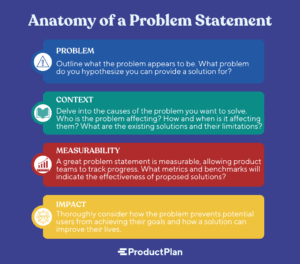For product teams, having a well-defined and researched problem statement can be crucial to the success of their product development. But how exactly do you create one?
Product teams should start by considering the components of a problem statement.
Key Components of a Problem Statement
- Problem: Outline what the problem appears to be. What problem do you hypothesize you can provide a solution for? Don’t make assumptions about the solution until you understand the issue more deeply.
- Context: Delve into the causes of the problem you want to solve. Who exactly is the problem affecting? How and when is it affecting them? What are the existing solutions and their limitations? Understanding the context, a pivotal part of the process, equips you with the necessary knowledge to craft a comprehensive problem statement, making you feel more informed and prepared.
- Scope: It is just as important to understand what your product will not solve as it is to know what you are solving for. Defining the boundaries of the problem prevents scope creep and ensures focused efforts when designing a solution.
- Measurability: A strong problem statement is measurable, allowing product teams to track progress and success. For instance, if you run a pizza delivery business and have a high online order abandonment rate, your measurable problem statement can include “Decrease the abandonment rate by 15% within a month.” Metrics and benchmarks provide quantifiable targets, guiding the effectiveness of proposed solutions.
- Impact: Thoroughly consider how the problem prevents potential buyers from achieving their goals and how a solution can improve their lives–will it improve their day-to-day operations or reputation? Will there be significant positive impacts in the way they work? The potential impact of your solution is a source of motivation and inspiration throughout your product development journey.

When should I create a problem statement?
- Product Discovery: At the inception of a new product or feature, a well-crafted problem statement lays the groundwork for discovery and planning. It guides prioritization, manages resource allocation, and calls attention to the needs of the population you’re solving for.
- Market Research: Problem statements are invaluable in market research by framing discussions and questions. They help uncover pain points, preferences, and behavior, informing user personas and journey mapping.
- Design Thinking: In design thinking processes, problem statements are the starting point for empathizing with users and brainstorming creative solutions. They foster a human-centered approach, demanding a thorough understanding of what your customers both think and feel. An effective problem statement will ensure that solutions address real-world needs with the end user in mind.
- Agile Development: Within agile frameworks, problem statements provide a north star for sprint planning and backlog refinement. They empower cross-functional teams to collaborate productively towards common objectives.
- Continuous Improvement: Problem statements are not fixed; they evolve as products and markets do. Suppose you are working on a project to develop a new mobile game. If you discover that your target audience has shifted from teenagers to adults, you may need to adjust your problem statement to ensure that your game’s content and features are relevant and interesting to this new demographic. Regularly revisiting and refining problem statements ensures that product development remains responsive to changing needs and dynamics.
Examples by Industry
At ProductPlan, we have the unique opportunity to see how product folks from a variety of industries craft their problem statements. Here are a few examples based on what we’ve seen from our customers:
Financial Services: Customers are experiencing an average transaction processing delay of 48 hours, leading to a 15% increase in complaints and decreased customer satisfaction.
Healthcare: Patients are waiting an average of 3 weeks for non-emergency appointments, resulting in a 25% decrease in patient satisfaction and increased strain on emergency services.
Insurance: Policyholders are facing a 30% claim rejection rate due to unclear documentation requirements, leading to a rise in customer dissatisfaction and retention issues.
Telecommunications: Customers are experiencing a 10% drop in network reliability during peak hours, resulting in increased complaints and customer churn.
Food and Beverage: Restaurant chains are seeing a 15% increase in food waste, contributing to higher operational costs and environmental concerns.



